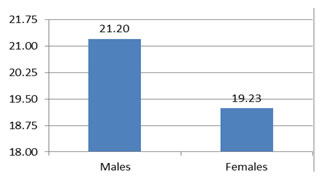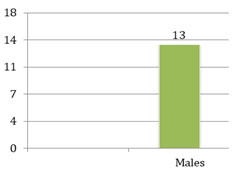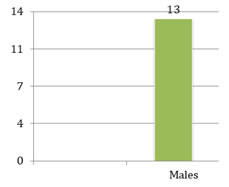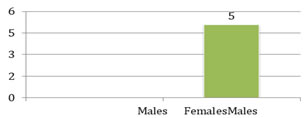Official Journals By StatPerson Publication
|
Table of Content Volume 13 Issue 2 - February 2020
Joash Jayaraj1, G Gopalakrishnan2, Sunil Kumar Giriyappa Patil3*, B Harimanasa4
Department of Psychiatry, MVJ Medical College and Research Hospital, Hoskote, Bangalore - 562114, Karnataka, INDIA Email: drsunilgp@gmail.com
Abstract Background and Objectives : There is a paucity of research literature on the variations in temperamental traits between males and females specific for alcohol dependence. Temperament refers to the individual differences in the automatic response to emotional stimuli which abide by by the norms of associative conditioning or procedural learning of habits and skills. The main objective of this study was to assess the differences in temperamental traits of males and females with alcohol dependence. Materials and Methods: 30 males and 30 females with a diagnosis of alcohol dependence syndrome based on ICD - 10 Criteria were recruited from Department of Psychiatry, MVJMC and RH Bangalore. The Temperament and character inventory - Revised was administered to assess the scores on temperamental traits. Student’s t test was applied to find the significance of ‘p’ value. SPSS software was used for data analysis. Results: Scoring was done on four dimensions - Novelty seeking, Harm avoidance, Reward dependence and Persistence. There was no significant difference in the scores on Novelty seeking, Harm avoidance, Reward dependence. The findings were not statistically significant. The mean scores of males was 5.07 and that of females is 4.13. Females had lower scores compared to males on Persistence. The difference was statistically significant. (p = 0.0360 ) Discussion and Conclusion: This study is unique as it is one of the few studies focussing on gender differences in temperamental traits in alcohol dependence. Lower scores on persistence in women indicate that they have a greater severity of addiction. It aids in the early detection of at risk drinkers which is a priority from a public health perspective because of the high prevalence of risk consumption. It also helps us in identifying the risk for adolescent substance misuse in early childhood through temperamental traits. Key Words: TCI - R, Novelty, Avoidance, Reward, Persistence
INTRODUCTION There is a paucity of research literature on the variations in temperamental traits between males and females specific for alcohol dependence. This study encompasses valuable clinical implications. It endeavors to enhance our understanding of the gender specific temperament traits for alcohol use. Cloninger et al. has shed light on four temperament dimensions - Harm avoidance, Novelty seeking, reward dependence and persistence. He concluded that harm avoidance trait would be more specific for alcoholism.1 Temperament refers to the individual differences in the automatic response to emotional stimuli which abide by by the norms of associative conditioning or procedural learning of habits and skills.2 It has been defined as those facets of personality which is heritable, fully manifest in infancy and stable throughout life. Temperament traits include basic emotional response patterns such as fear versus calm, thrill versus anger, disgust versus attachment and tenacity versus discouragement.4 Moreover, only few studies have emphasized on temperament traits in women with alcohol dependence when compared to men. It is important to note that alcohol use disorders is on the rise in females. Alcohol affects women differently than men. Dependence on alcohol occurs earlier in females than men due to the large distribution of adipose tissue. It is of particular interest to consider that alcohol causes significant health problems during pregnancy in females namely fetal alcohol syndrome.5 Caspi et al. and Kruger et al. stated in their findings that traits related to appetitive and unrestrained behavioral tendencies were noted in the harmful patterns of alcohol use and general internalizing problems.3,6 Temperament can be assessed in terms of the four TCI dimensions previously mentioned. The four TCI temperaments correspond roughly to the ancient Greek temperaments as described by Hippocrates and others: Harm Avoidance and melancholic humor, Novelty Seeking and choleric humor, Reward Dependence and sanguine humor, and Persistence and phlegmatic humor. Women have increased their alcohol consumption during the decades. A lot of women drink and drink more often. They also consume larger amounts when drinking. Credible knowledge about the factors of etiological significance in female alcohol abuse is still lacking.7 Alcoholic women start drinking and begin their pattern of abuse at a later stage. Alcoholic women have a preference to drink alone. They seek help with a shorter duration of alcoholism.8 Women have a greater vulnerability to hepatic disorder than men. They seek help more for the co morbid problems than for the primary one. Temperamental factors, specifically high activity, high emotionality, low capacity for self‑soothing, low attention span‑persistence, and low sociability are associated with a high risk for alcoholism.9 Early temperament dysregulation may increase risk for childhood behavior problems that in turn evolve into substance abuse during adolescence. Moreover, there is some evidence to suggest that temperamental difficulties might mediate the relationship between parental alcoholism and childhood problems. 10 Novelty Seeking, Reward Dependence, and Persistence are also moderately heritable and stable dimensions of temperament. Each extreme of temperament has both advantages and disadvantages, so there is no “good” or “bad” temperament, just different emotional styles of adaptation.15 As early as infancy, apparent markers of temperament including high novelty seeking and low harm avoidance, appear to predict adolescent onset of drinking. The risk for adolescent substance misuse may be identified in early childhood through temperamental traits.17,18 Parkitna JR showed that metabotropic glutamate receptor 5 (mGluR5) signaling on dopaminoceptive neurons is vital for both novelty-seeking behavior and the abstinence induced escalation of alcohol drinking. 19 Given that the response to novelty is the basis of the definition of sensation seeking, individual differences in reactivity to novelty have been studied on behavioral and biological levels.20 Dimensional personality measures described as associated with better outcomes include high persistence, high extroversion, low harm avoidance and low novelty seeking.21 Persistence predicted relapse latency even when the other predictors were used as covariates, supporting the hypothesis that normal-range personality variables may enhance the prediction of clinical outcome. 22 High anxiety as a stable trait, and personality traits such as high novelty seeking and low harm avoidance predicted relapse.24 There is also evidence in literature to suggest that temperament deviations in child hood may heighten the risk for alcoholism in adulthood. These temperament deviations might indicate a behavioural genetic marker for alcoholism.25 Temperament difficulties may exacerbate childhood troublesome behaviors and result in an insecure attachment with the child's primary caregiver. 26 Pournaghash-Tehran S et al. in their significant study revealed that higher scores on temperament dimensions of novelty seeking and reward dependence predicted poorer retention across endpoints, whereas only higher scores on persistence predicted greater relapse.27 Marra D et al. postulated that Type 2 alcoholics (Cloninger's classification) scored higher on the Thrill and Adventure Seeking Subscale.28 In an appreciable study by Meszaros et al., logistic regression analysis of the results showed that novelty seeking is a strong predictor for relapse in detoxified male alcoholics (p = 0.0007), but not in females. 29 Pombo S offered novel insights about the role of affective temperaments in alcohol addictioni predicting short-term relapse in detoxified male alcohol-dependent patients.30 This study would help us in identifying young boys and girls in the community with temperament traits that could predispose them to developing alcohol dependence in the long run thereby, modifying strategies ( such as psychoeducation) in the prevention of alcohol addiction. MATERIALS AND METHODS Study Design: This was a cross sectional observational study. Study Setting: The study was set at Department of Psychiatry, MVJMC and RH, Hoskote, Bangalore, a tertiary care referral hospital, comprising of inpatients and outpatients with a diagnosis of alcohol dependence syndrome. 4.3 Study Period: 1 year 4.4 Study Population: 30 males and 30 females of age group 20 to 60 years diagnosed with alcohol dependence syndrome based on ICD 10 criteria at MVJ Medical College and Research Hospital, Hoskote, Bangalore.
Method of collection of data (including sampling procedure): Sampling procedure : The patients were recruited and the data was collected over a period of 1 year (NOV 2018 - NOV 2019). Selection was made in a serial consecutive manner from among inpatients and outpatients who volunteer to participate in the study at Department of Psychiatry, MVJMC and RH, Hoskote, Bangalore. Informed Consent was taken from the participants. Inclusion Criteria: a. Male and female patients with an ICD 10 diagnosis of alcohol dependence syndrome b. Age group of 20 to 60 years c. Written Informed consent Exclusion Criteria: a. Those with comorbid substance use disorders other than nicotine use disorder b. Those with comorbid psychiatric disorders Instruments : Temperament and character inventory - Revised The Cloninger temperament and character inventory version(TCI-R) is a 240 item questionnaire. The TCI-R comprises of 140 questions. Scoring was done on the four temperamental dimensions - Novelty seeking, Harm Avoidance, Reward dependence and Persistence [2]. The Kannada version of the scale was used for those who were not comfortable in English. The total score for the novelty seeking dimension was the sum of the scores on four sub scales of the dimension namely Exploratory excitability (NS1), Impulsiveness (NS2), Extravagance (NS3) and Disorderliness (NS4). The total score for the Harm Avoidance dimension was the sum of the scores on four sub scales of the dimension namely Anticipatory worry (HA1), Fear of uncertainty (HA2), Shyness/Shyness with strangers (HA3) and Fatiguability/Fatiguability and asthenia (HA4). The total score for the reward dependence dimension was the sum of the scores on three sub scales of the dimension namely Sentimentality (RD1), Attachment (RD2) and dependence (RD3). Persistence lacks sub scales and the total score is based on the responses. The TCI provides a gentle and encouraging language by which patient and psychiatrist can communicate respectfully and hopefully. The TCI is dependent in part on patient's truthfulness and self-understanding in a self-report.
Statistics The data was entered first into Microsoft Excel 2013 into tabular form. Statistical analysis of the data was done on the SPSS version 22.0 (Statistical Package for Social Sciences software). The tables depicting prevalence and correlation between variables were made using SPSS version 22.0. Frequency distribution was done for the sociodemographic variables. Student’s t test was used to find the differences in the mean scores on the four dimensions of temperamental traits.The relevant data was depicted in form of pie charts and bar diagrams. The p value <0.05 was considered significant.
RESULTS Sociodemographic characteristics: 50 % of the subjects were males and 50 % were females in our study 6.7% patients belonged to age group 25 - 35 years, the majority ( 51.7%) belonged to 36 - 45 years, 36.7% belonged to 46 - 55 years and 5% of them were > 55 years. 85 % of the patients were employed and 15 % were unemployed. 8.3 % patients had studied till primary school ; 40 % had completed their 10th std ; 36.7 % patients had studied till PUC and 15 % of them were qualified with a degree among whom were a few postgraduates as well. A majority of the patients ( 76.7 % ) were married 23.3 % of them were unmarried. 28.3 % of the patients were dependent on alcohol for 1 year, 48.3 % of them were dependent for 1 - 5 years and 23.3 % were diagnosed with dependence for more than 5 years. 68.3 % patients were under some form of treatment for alcohol dependence when taken up for this study ; 31.7 % patients were treatment naive. 78.3 % of the patients had a history of alcohol dependence syndrome in atleast one family member; 21.7 % patients had a negative family history of ADS. 38.3 % patients did not have any psychiatric or medical comorbidity; 61.7 % patients had a psychiatric comorbidity ; 50 % of the patients had atleast one medical illness comorbid with ADS. Temperamental traits :
In this study, males scored an average of 21.20 on the temperament and character inventory on the novelty seeking trait and females scored an average of 19.23. There was no significant difference in this trait between males and females as depicted by the p value ( P value = 0.151 ) Graph 1: Novelty Seeking
II. Harm Avoidance In this study, males scored an average of 13.40 on the temperament and character inventory on the harm avoidance trait and females scored an average of 14.60. There was no significant difference in this trait between males and females as depicted by the p value ( P value = 0.461 )
Graph 2: HARM AVOIDANCE
III. Reward Dependence In this study, males scored an average of 13.30 on the temperament and character inventory on the reward dependence trait and females scored an average of 12.53. Graph 3: REWARD DEPENDENCE
IV. PERSISTENCE Males scored an average of 5.07 on the temperament and character inventory on the persistence trait and females scored an average of 4.13. The standard deviation for males is 1.388 and females is 1.943. Significant difference in this trait was observed between males and females as depicted by the p value ( P value = 0.0360 )
Graph 4: PERSISTENCE DISCUSSION The main objective of our study was to assess the the differences in temperamental traits between males and females with alcohol dependence syndrome. The study was done over a period of one year from November 2018 to November 2019. A sample size of 60 patients, 30 males and 30 females were taken up for the study. Our study was a cross sectional observational study and written informed consent was taken in the language best understood by the patients. The Cloninger’s Temperament and Character Inventory Revised was used to assess the patients on the four temperament traits namely Novelty seeking, Harm Avoidance, Reward dependence and Persistence. Many other established studies involving larger samples have used the TCI-R as a valid and reliable instrument to assess the temperamental traits and has yielded appreciable results 3,8,11, 12 Though the sample size was small, our study had recruited equal number of males and females ( 30 males and 30 females ). In other similar studies, the sample size was larger but the sex distribution was not equal often comprising of more males compared to females. In one important study by Alvarez A et al. in 2018, 250 men and 54 women were enrolled. That is 82.2% males and 17.8% females as compared to 50% males and 50% females in our study. We had enrolled an equal number of the sexes so that the results could be more precise and the chances of over or under representation could be minimized. 13 On the novelty seeking trait, the mean score of males was 21.20 and that of females was 19.23. The standard deviation of the scores was 5.985 for males and 4.360 for females. As we had described earlier, novelty seeking refers to the hereditary tendency towards the search for excitement and interest in novel stimuli. Males scored slightly higher than females which was expected. This is in line with another study by Alvarez A wherein both males and females and scored high on search for novelty 12. Another established study by Milivojevic et al. in Belgrade, Serbia echoed similar findings wherein subjects with alcohol addiction scored significant higher on novelty seeking compared to controls13. Novelty seeking potentiates the risk of early experimentation with drugs. In our study however, there was no statistical significance in the difference on novelty seeking between males and females ( p = 0.151 ) . Harm avoidance denotes the hereditary tendency to respond intensely to signs of adverse stimuli and conditions avoidance to aversive stimuli. In our study, we observed that males scored a mean of 13.40 and females scored 14.60. The standard deviation of the scores was 5.775 and 6.714 respectively. Females appeared to be more cautious, apprehensive and fearful of aversion and avoided damage and harm more often than males as reflected by a slightly higher score ( 14.60 ). But this score was not found to be statistically significant ( p = 0.461 ). The study on inpatients at a specialized hospital for chemical dependency by Milivojevic D et al.. corroborated this finding wherein around 100 subjects (64 males and 36 females) scored high on harm avoidance without any statistically significant difference 16. A large Brazilian web survey conducted by Schneider Jr R in 2015 found similar findings 12 People with alcohol dependence tend to be socially detached and insensitive to social cues and social approval. It is also known that they are not affected by separation from the group. This trait known as reward dependence was also assessed in our study. Males scored a mean of 13.30 and females scored 12.53 on the TCI specific for this trait. The standard deviation of the scores was 2.718 and 4.133 respectively. In another study by Alvarez A, the subjects had scored high on reward dependence with no mention of the gender influence on the trait13 But in yet another study, Milivojevic et al. found a relatively lower score on reward dependence compared to controls which was in line with our finding 16 Females in our study appeared to be slightly more aloof and socially detached as reflected by their lower mean score compared to males which heightens the vulnerability to choose alcohol but the difference between the sexes was not statistically significant. The fourth yet significant trait that was keenly studied was persistence. Persistence is defined as the neurobiological tendency to maintain behaviors under conditions of extinction. It is associated with serotonergic transmission and orbitofrontal circuits. 23 The mean score of males on this trait was 5.07 and that of females was 4.13 respectively. The standard deviation of the scores for males and females was 1.388 and 1.943 respectively. The difference in the scores was found to be statistically significant ( p = 0.0360 ). Females scored significantly lower compared to males which led us to conclude that they were less ambitious and perfectionistic compared to males. In yet another study by Alvarez A, the researchers found that women had scored lower in persistence which reflected a greater severity of their addiction, greater intensity of alcohol dependence, greater obsession and greater craving for alcohol than men 13. This finding corroborates with the statistically significant finding in our study.
LIMITATIONS
CONCLUSION This study has emphasized the notion that temperamental traits can help us identify at risk drinkers in the community. The awareness created through this study can curtail the chances of young boys and girls getting ensnared in the vicious web of alcohol misuse and addiction. This can have far reaching effects on women of child bearing age who can be protected from pregnancy related complications due to alcohol by nipping the menace in the bud. Women with alcohol dependence were found to be less persistent than males. This vital finding could be very well incorporated in psychoeducation strategies aimed at preventing alcohol addiction in men and women.
REFERENCES
Policy for Articles with Open Access |
|
 Home
Home




